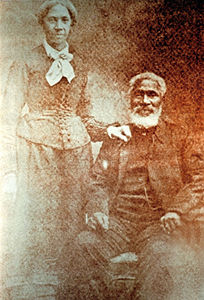
Josiah Henson, spiritual leader, author, founder of the Black community settlement at Dawn, Canada West (born 15 June 1789 in Charles County, Maryland; died 5 May 1883 in Dresden, ON). Born enslaved, Henson escaped to Upper Canada in 1830. He founded the Dawn Settlement near Dresden, Upper Canada, for American fugitives from enslavement. He and a group of associates organized a trade-labour school, the British-American Institute. He was active on the executive committee until the Institute closed in 1868. Henson served as Dawn's spiritual leader and patriarch and made numerous fundraising trips to the United States and England. He published his autobiography in 1849, and he was allegedly Harriet Beecher Stowe's model for the lead character in her novel Uncle Tom's Cabin (1852).
This Secret Life of Canada episode tries to figure out the true story of Uncle Tom, with the help of Dr. Cheryl Thompson. You may know “Uncle Tom” as a derogatory term. Or from Harriet Beecher Stowe’s 1852 anti-slavery novel “Uncle Tom’s Cabin”. But the name’s also linked to Josiah Henson, who escaped to Canada through the Underground Railroad. So which one is right?
Note: The Secret Life of Canada is hosted and written by Falen Johnson and Leah Simone Bowen and is a CBC original podcast independent of The Canadian Encyclopedia.
Escape to Upper Canada
Henson first tried to buy his freedom in 1825. His owner, Isaac Riley, needed money, and sent Henson to escort a group of 18 enslaved persons to Kentucky. While in transit, the group could easily have escaped to Ohio and made themselves free, but Henson believed his owner's offer of manumission (ownership of himself). Consequently, he would not allow the escape and was later disappointed when he realized that his owner had no intention of giving him his freedom. He was taken, along with his wife and four children, to New Orleans, Louisiana, in 1829 to be sold. Henson and his family fled to Upper Canada, reaching the Niagara Peninsula on 28 October 1830.
The Dawn Settlement
Henson and his family settled near Dresden, Upper Canada. With his leadership skills, he was able to command the support of abolitionists who helped him create the Dawn Settlement, a place for refugees from enslavement to gain the education and skills necessary for self-sufficiency and self-determination. It was Henson's belief that Black persons needed to learn skills within their own community. In 1841, Henson and his partners purchased 200 acres of land, and in 1842, they established the British-American Institute. A central focus of the settlement, the school was created for students of all ages and was sustainably designed to train teachers while providing general education and trade-labour instruction to members of the community. The community of Dawn developed around the Institute, with many residents farming, attending the Institute, and working in sawmills, gristmills and in other local industries.
After the Emancipation Proclamation of 1863, some members of the community returned or moved to the United States, though many remained at Dawn.
Henson as Fictionalized Character
Henson’s autobiography The Life of Josiah Henson, Formerly a Slave, Now an Inhabitant of Canada (1849) was published in order to raise funds for the continuation of the Dawn Settlement. Many consider Henson’s autobiography to be the inspiration for the lead character in Harriet Beecher Stowe’s novel, Uncle Tom’s Cabin.
Some have expressed concern over Josiah Henson as the model for the Uncle Tom character in Beecher Stowe's novel, Uncle Tom’s Cabin. Though written and published as an anti-slavery text, the book portrayed Black persons in a stereotypical manner.

 Share on Facebook
Share on Facebook Share on X
Share on X Share by Email
Share by Email Share on Google Classroom
Share on Google Classroom
